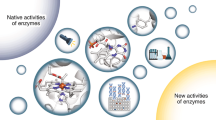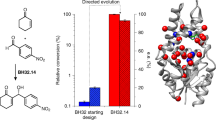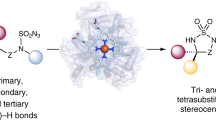Abstract
Enzyme engineering has allowed not only the de novo creation of active sites catalysing known biological reactions with rates close to diffusion limits, but also the generation of abiological sites performing new-to-nature reactions. However, the catalytic advantages of engineering multiple active sites into a single protein scaffold are yet to be established. Here, we report on proteins with two active sites of biological and/or abiological origin, for improved natural and non-natural catalysis. The approach increased the catalytic properties, such as enzyme efficiency, substrate scope, stereoselectivity and optimal temperature window, of an esterase containing two biological sites. Then, one of the active sites was metamorphosed into a metal-complex chemocatalytic site for oxidation and Friedel–Crafts alkylation reactions, facilitating synergistic chemo- and biocatalysis in a single protein. The transformations of 1-naphthyl acetate into 1,4-naphthoquinone (conversion approx. 100%) and vinyl crotonate and benzene into 3-phenylbutyric acid (≥83%; e.e. >99.9%) were achieved in one pot with this artificial multifunctional metalloenzyme.
This is a preview of subscription content, access via your institution
Access options
Access Nature and 54 other Nature Portfolio journals
Get Nature+, our best-value online-access subscription
$29.99 / 30 days
cancel any time
Subscribe to this journal
Receive 12 digital issues and online access to articles
$119.00 per year
only $9.92 per issue
Buy this article
- Purchase on Springer Link
- Instant access to full article PDF
Prices may be subject to local taxes which are calculated during checkout








Similar content being viewed by others
References
Bren, K. L. Engineered biomolecular catalysts. J. Am. Chem. Soc. 139, 14331–14334 (2017).
Ebert, M. C. & Pelletier, J. N. Computational tools for enzyme improvement: why everyone can - and should - use them. Curr. Opin. Chem. Biol. 37, 89–96 (2017).
Arnold, F. H. Directed evolution: bringing new chemistry to life. Angew. Chem. Int. Ed. 57, 4143–4148 (2018).
Acebes, S. et al. Rational enzyme engineering through biophysical and biochemical modeling. ACS Catal. 6, 1624–1629 (2016).
Seelig, B. & Szostak, J. W. Selection and evolution of enzymes from a partially randomized non-catalytic scaffold. Nature 448, 828–831 (2007).
Jiang, L. et al. De novo computational design of retro-aldol enzymes. Science 319, 1387–1391 (2008).
Richter, F. et al. Computational design of catalytic dyads and oxyanion holes for ester hydrolysis. J. Am. Chem. Soc. 134, 16197–16206 (2012).
Rufo, C. M. et al. Short peptides self-assemble to produce catalytic amyloids. Nat. Chem. 6, 303–309 (2014).
Moroz, Y. S. et al. New tricks for old proteins: single mutations in a nonenzymatic protein give rise to various enzymatic activities. J. Am. Chem. Soc. 137, 14905–14911 (2015).
Blomberg, R. et al. Precision is essential for efficient catalysis in an evolved Kemp eliminase. Nature 503, 418–421 (2013).
Khersonsky, O. et al. Optimization of the in-silico-designed Kemp eliminase KE70 by computational design and directed evolution. J. Mol. Biol. 407, 391–412 (2011).
Röthlisberger, D. et al. Kemp elimination catalysts by computational enzyme design. Nature 453, 190–195 (2008).
Wilson, M. E. & Whitesides, G. M. Conversion of a protein to a homogeneous asymmetric hydrogenation catalyst by site-specific modification with a diphosphinerhodium(I) moiety. J. Am. Chem. Soc. 100, 306–307 (1978).
Dydio, P. et al. An artificial metalloenzyme with the kinetics of native enzymes. Science 354, 102–106 (2016).
Lewis, J. C. Artificial metalloenzymes and metallopeptide catalysts for organic synthesis. ACS Catal. 3, 2954–2975 (2013).
Jeschek, M. et al. Directed evolution of artificial metalloenzymes for in vivo metathesis. Nature 537, 661–665 (2013).
Drienovská, I. et al. Novel artificial metalloenzymes by in vivo incorporation of metal-binding unnatural amino acids. Chem. Sci. 6, 770–776 (2015).
Bos, J. et al. Enantioselective artificial metalloenzymes by creation of a novel active site at the protein dimer interface. Angew. Chem. Int. Ed. 51, 7472–7475 (2012).
Lin, Y.-W. et al. Rational design of heterodimeric protein using domain swapping for myoglobin. Angew. Chem. Int. Ed. 54, 511–515 (2015).
Farid, T. A. Elementary tetrahelical protein design for diverse oxidoreductase functions. Nat. Chem. Biol. 9, 826–833 (2013).
Roy, A. et al. De novo design of an artificial bis[4Fe-4S] binding protein. Biochemistry 52, 7586–7594 (2013)..
Tebo, A. G. & Pecoraro, V. L. Artificial metalloenzymes derived from three-helix bundles. Curr. Opin. Chem. Biol. 25, 65–70 (2015).
Felice, M. et al. Synthesis of a heterogeneous artificial metallolipase with chimeric catalytic activity. Chem. Commun. 51, 9324–9327 (2015).
Santiago, G. et al. Rational engineering of multiple active sites in an ester hydrolase. Biochemistry 57, 2245–2255 (2018).
Zollner H. Handbook of Enzyme Inhibitors (Wiley‐VCH, 1999).
Myers, D. K. Competition of the aliesterase in rat serum with the pseudo cholinesterase for diisopropyl fluorophosphonate. Science 115, 568–570 (1952).
Beller M., Renken A. & van Santen R. A. Catalysis: From Principles to Applications (Wiley-VCH, 2012).
Schwizer, F. et al. Artificial metalloenzymes: reaction scope and optimization strategies. Chem. Rev. 118, 142–231 (2018).
Wang, T. et al. Rational redesign of the active site of selenosubtilisin with strongly enhanced glutathione peroxidase activity. J. Catal. 359, 27–35 (2018).
Hoque, M. A. et al. Stepwise loop insertion strategy for active site remodeling to generate novel enzyme functions. ACS Chem. Biol. 12, 1188–1193 (2017).
Payer, S. E. et al. A rational active-site redesign converts a decarboxylase into a C=C hydratase: “Tethered Acetate” supports enantioselective hydration of 4-hydroxystyrenes. ACS Catal. 8, 2438–2442 (2018).
Zastrow, M. L. & Pecoraro, V. L. Influence of active site location on catalytic activity in de novo-designed zinc metalloenzymes. J. Am. Chem. Soc. 135, 5895–5903 (2013).
Ross, M. R. et al. Histidine orientation modulates the structure and dynamics of a de novo metalloenzyme active site. J. Am. Chem. Soc. 137, 10164–10176 (2015).
Der, B. S., Edwards, D. R. & Kuhlman, B. Catalysis by a de novo zinc-mediated protein interface: implications for natural enzyme evolution and rational enzyme engineering. Biochemistry 51, 3933–3940 (2012).
Khare, S. D. et al. Computational redesign of a mononuclear zinc metalloenzyme for organophosphate hydrolysis. Nat. Chem. Biol. 8, 294–300 (2012).
Zastrow, M. L. et al. Hydrolytic catalysis and structural stabilization in a designed metalloprotein. Nat. Chem. 4, 118–123 (2012).
Zandonella, G. et al. Interactions of fluorescent triacylglycerol analogs covalently bound to the active site of a lipase from Rhizopus oryzae. Eur. J. Biochem. 262, 63–69 (1999).
Tokuriki, N. et al. Diminishing returns and tradeoffs constrain the laboratory optimization of an enzyme. Nat. Commun. 3, 1257 (2012).
Koelsch, C. F., Hochmann, H. & Le Claire, C. D. The Friedel–Crafts reaction with cinnamic, crotonic, and β-chlorocrotonic acids. J. Am. Chem. Soc. 65, 59–60 (1943).
Blanco, R. M. & Guisán, J. M. Stabilization of enzymes by multipoint covalent attachment to agarose-aldehyde gels. Borohydride reduction of trypsin-agarose derivatives. Enzym. Microb. Technol. 11, 360–366 (1989).
Lecina, D., Gilabert, J. F. & Guallar, V. Adaptive simulations, towards interactive protein-ligand modeling. Sci. Rep. 7, 8466 (2017).
Acknowledgements
This work was funded by grant ‘INMARE’ from the European Union’s Horizon 2020 (grant agreement no. 634486), grants PCIN-2017-078 (within the Marine Biotechnology ERA-NET), CTQ2016-79138-R, BIO2016-76601-C3-1-R, BIO2016-76601-C3-3-R, BIO2017-85522-R, RTI2018-095166-B-I00 and RTI2018-095090-B-100 from the Ministerio de Economía y Competitividad, the Ministerio de Ciencia, Innovación y Universidades (MCIU), the Agencia Estatal de Investigación (AEI), the Fondo Europeo de Desarrollo Regional (FEDER) and the European Union (EU). P.N.G. and R.B. acknowledge the support of the UK Biotechnology and Biological Sciences Research Council (BBSRC; grant No. BB/M029085/1) and the Centre of Environmental Biotechnology Project and the Supercomputing Wales project, which are partly funded by the European Regional Development Fund (ERDF) through the Welsh Government. The authors gratefully acknowledge the financial support provided by the ERDF. C.C. thanks the Ministerio de Economía y Competitividad and FEDER for a Ph.D. fellowship (Grant BES-2015-073829). J.L.G.-A. thanks the support of the Spanish Ministry of Education, Culture and Sport through the National Program FPU (FPU17/00044). I.C.-R. thanks the Regional Government of Madrid for a fellowship (PEJ_BIO_AI_1201). The authors would like to acknowledge S. Ciordia and M. C. Mena for MALDI-TOF/TOF analysis. We thank the staff of both the European Synchrotron Radiation Facility (ESRF, Grenoble, France), for providing access and technical assistance at beamline ID30A-1/MASSIf-1, and the Synchrotron Radiation Source at Alba (Barcelona, Spain), for assistance at BL13-XALOC beamline. The authors would also like to acknowledge M. J. Vicente and M. A. Pascual at the Servicio Interdepartamental de Investigación (SIDI) of the Autonomous University of Madrid for the ESI-MS analyses.
Author information
Authors and Affiliations
Contributions
S.A., G.S. and I.C.-R. contributed equally to this work. The manuscript was written through contributions from M.F., V.G., J.S.-A. and P.S. All the authors have given approval to the final version of the manuscript. S.A., C.C., L.F.-L., M.M.-M., H.M. and P.N.G. contributed to site-directed mutagenesis and protein expression, purification and characterization. J.M. and A.K.R. coordinated, in collaboration with M.F., the synthesis of the suicide inhibitor. R.B. contributed to the biochemical data analysis. D.R. and C.B. contribute to the GC analyses for enantioselectivity determination. J.L.G.-A. and F.J.P. performed HPLC analysis of the reaction products. G.S. and V.G. conducted the PELE simulations and molecular dynamics. M.P. contributed together with S.A. and L.F.-L. to the electrochemical measurements and discussion. I.C.-R. and J.S.-A. performed the crystallization and X-ray structure determinations. M.B. contributed to the development of the protocol for the inhibition procedure. M.F. and V.G. conceived the plurizyme work, and M.F. and P.S. conceived the metamorphosis of the enzymatic to the chemical catalyst. M.F. wrote the initial draft of the manuscript, which was further supplemented through contributions from V.G., J.S.-A. and P.S.
Corresponding authors
Ethics declarations
Competing interests
The authors declare no competing interests.
Additional information
Publisher’s note Springer Nature remains neutral with regard to jurisdictional claims in published maps and institutional affiliations.
Supplementary information
Supplementary Information
Supplementary Notes 1–12, Figures 1–36, Tables 1–8, methods and references.
6I8F
Atomic coordinates for PDB ID 6I8F
6RB0
Atomic coordinates for PDB ID 6RB0
6RKY
Atomic coordinates for PDB ID 6RKY
Rights and permissions
About this article
Cite this article
Alonso, S., Santiago, G., Cea-Rama, I. et al. Genetically engineered proteins with two active sites for enhanced biocatalysis and synergistic chemo- and biocatalysis. Nat Catal 3, 319–328 (2020). https://doi.org/10.1038/s41929-019-0394-4
Received:
Accepted:
Published:
Issue Date:
DOI: https://doi.org/10.1038/s41929-019-0394-4
This article is cited by
-
Pickering emulsion droplets and solid microspheres acting synergistically for continuous-flow cascade reactions
Nature Catalysis (2024)
-
Sub-micro- and nano-sized polyethylene terephthalate deconstruction with engineered protein nanopores
Nature Catalysis (2023)
-
Synthetic prodrug design enables biocatalytic activation in mice to elicit tumor growth suppression
Nature Communications (2022)
-
Integrating single-cobalt-site and electric field of boron nitride in dechlorination electrocatalysts by bioinspired design
Nature Communications (2021)
-
Development of a versatile and efficient C–N lyase platform for asymmetric hydroamination via computational enzyme redesign
Nature Catalysis (2021)



